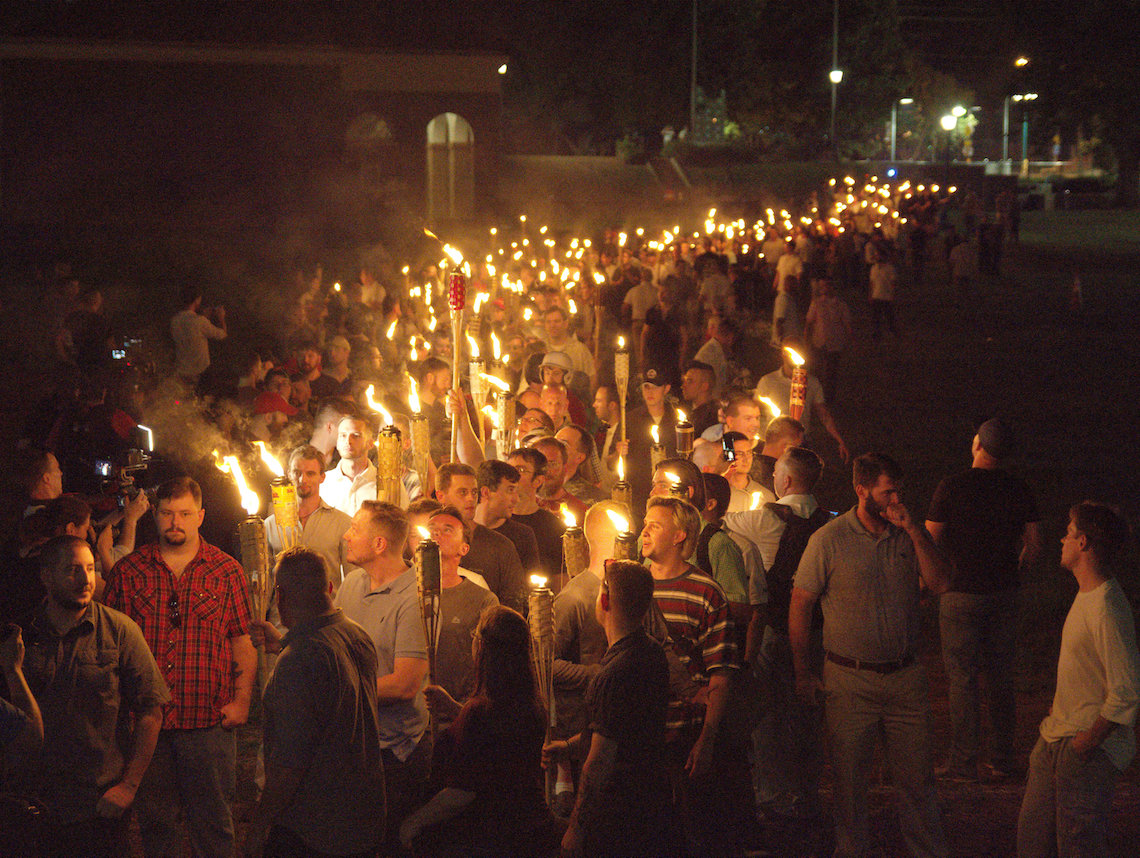 White nationalists carry torches on the grounds of the University of Virginia, on the eve of a planned Unite The Right rally in Charlottesville, Virginia, U.S. August 11, 2017. Picture taken August 11, 2017. Photo by Alejandro Alvarez/News2Share via REUTERS.
White nationalists carry torches on the grounds of the University of Virginia, on the eve of a planned Unite The Right rally in Charlottesville, Virginia, U.S. August 11, 2017. Picture taken August 11, 2017. Photo by Alejandro Alvarez/News2Share via REUTERS. Can neo-Nazis marching in Charlottesville, Va., be fodder for a meaningful conversation with a 10-year-old? Can an 8-year-old really think about anti-Semitism in contemporary America? The answer, quite simply, is yes.
With recent white supremacist rallies in Charlottesville, Boston and Laguna Beach, the chances are pretty good that your children already know about troubling current events.
As director of the Children’s Learning About Israel Project, I’ve spent the past five years studying how elementary school children process the world around them. As we’ve followed a group of Los Angeles children from ages 5 to 10, we’ve learned quite a lot about how children make sense of current events that happen removed from their own homes yet still impact their communities.
Here are three important lessons we’ve learned from the children we’ve been following:
• Kids will learn about difficult current events whether you want them to or not.
Childhood can be a wondrous, magical time. In an effort to help protect the sanctity of childhood, adults often want to shield children from controversial or complex current events. But in this era of easily accessible information, even if adults want to shield children from the harsh realities of the world, it isn’t likely that they can.
The children we’ve been following didn’t need to sit in a classroom lesson or read a newspaper to learn about the most contentious or the most tragic moments happening in the world around them. They looked over a mother’s shoulder as she scrolled through Facebook, or they caught glimpses of a television newscast — sometimes in a public place, sometimes in their own homes — that replayed violent images. They overheard conversations between adults, or they searched for information online. The information often came in bits and pieces, and — like a giant puzzle — the children began to piece together stories whether or not they had all the pieces. For most children in our study, this puzzle-piecing started as early as second grade.
Given the pervasiveness of the 24-hour news cycle and the prevalence of screens big and small, even if your children do not yet know about the rise of white supremacy in 2017 America, it will be difficult to shield them from this news for much longer. This means you have two options: let them work on the puzzle alone, or help frame it for them.
• Kids need adult guidance to help them understand the context and causes of current events.
Seeing images on a screen or overhearing conversations among adults is all it takes for kids to know what is going on. It isn’t enough, however, to help them understand why events happen or who participates in their occurrence. To understand this, kids need help from the trusted adults in their lives.
As we have watched the kids in our study watch the world around them, we’ve noticed that many children express a profound frustration that they are missing pieces of the puzzle because adults — who often have chosen to shield them from difficult or troubling news — have not sufficiently explained the context that would allow them to understand current events.
It is not enough for contemporary American-Jewish children to know that white supremacy and neo-Nazism are gaining traction in the United States, yet these are the very bits of information that kids are most likely to pick up on their own. Kids will need help to understand the context around this information: Who are white supremacists? How and why are racial minorities, Jews and others their targets? Most important, kids need to understand what is being done to counter hateful speech and actions, and who is and can be involved in this work, including the children themselves.
• In spite of it all, kids are optimists.
In part because adults understand so much more historical context than children, adults tend to look at troubling current events with fear and trepidation. But children are able to view the same events as their parents and grandparents and maintain hope that, in the end, all will be well and good in the world. As Anne Frank famously wrote, “In spite of everything I still believe that people are really good at heart.”
From the children in our study, we have learned that what may look to adults like disaster is, for children, an opportunity to remake the world. Even in the worst of times — as we watched the children’s reactions to the 2014 war in Israel, as rockets were raining on Israel and the children were coping with the deaths of Jewish youth — they remained hopeful optimists. For them, war was a chance to re-envision and pursue peace. So, too, can the rise of hatred, racism and anti-Semitism be, for children, an opportunity to rearticulate and embody principles of equality, inclusion and pluralism.
When talking to children about current events, adults have two jobs: to help children fill in the missing puzzle pieces, and to help them maintain the beautiful images they would like to create of the world. Children should be given an opportunity to learn about the world as it exists, and to become partners in creating the world as it should be. n























 More news and opinions than at a Shabbat dinner, right in your inbox.
More news and opinions than at a Shabbat dinner, right in your inbox.